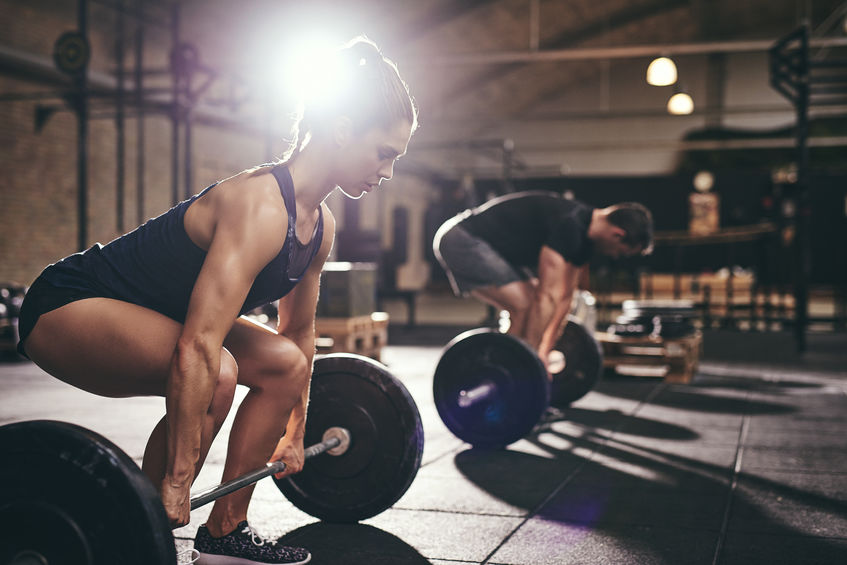In a recent article, we went over the often overlooked, but substantial health benefits of regular weightlifting. We can summarize the benefits by stating that it promotes lean muscle mass, fat loss, and overall physical and mental health.
Now that you know the benefits, you might be asking yourself what lifting techniques you could be doing to help your body reap the rewards. Here is a list of four weight lifts that are a staple in gyms everywhere for their remarkable strength-building and weight loss benefits.
Squats
Performing squats is arguably the most beneficial exercise you can do, as they can be performed easily with just your body weight. Squats directly affect all of the leg muscles, including your quadriceps (front of the leg), the hamstring (back of the leg), and your calves. These are the largest muscles found in the body, and squatting works them all at the same time. By working such large muscle groups at once, you are utilizing a lot of energy, which means higher calorie burn and a leaner body. Squats also benefit the rest of the body by triggering anabolic processes, which stimulate cell growth and increase in size. Stronger muscles result in a higher metabolism overall.
To squat correctly, follow these steps:
- Place feet slightly wider than the hips
- Hinge at the hips, sticking the glutes out
- Naturally ‘sit’ into your heels while keeping the entire foot on the ground
- Keep your chest up and shoulders back
- Drive through the heels back up to a standing position
Deadlifts

Similar to the squat, the deadlift can provide incredible health benefits as it works almost the entire body, including the legs, the butt, the lower back, the neck, the inner scapulae, the rhomboids (inner back), and the abs. It’s an incredible exercise, but one that must be performed correctly to avoid injury. Having the assistance of an expert personal trainer, such as Damen Griffith, can help with monitoring correct form not only for your safety but to get the maximum benefit of the workout.
To perform a deadlift correctly, follow these steps:
- Stand with feet slightly wider than shoulder-width
- Slightly bend the knees and hinge forward at the hips. Keep your back straight at all times
- Lower your body and grab the bar outside of the legs. Keep your chest up and eyes looking forward to help maintain form
- Drive through the heels, keeping the bar close to your body and exhaling as you stand
- Slowly lean forward, keeping the back straight and slightly bending the knees, and lower the bar back down to the ground
Rows
The row is an activity that engages the back, the shoulders, the biceps, and the core for stabilization. Rows can be completed in different ways, with the most common being dumbbell rows or barbell rows. Rows assist in building back strength and mitigating issues that involve it.
To complete dumbbell rows, follow these steps:
- Stand with the feet shoulder-width apart and a dumbbell in each hand
- Bend the knees slightly, hinge forward at the hips, and keep your back straight. The dumbbells should be hanging in front of your body
- Contract the back and pull the dumbbells up to your sides, keeping the elbows tucked in, and actively trying to squeeze the inner back muscles
- Lower the dumbbells to a hanging position while keeping the core stable and back straight
Bench Press (Chest Press)
The bench press is probably the most stereotypically referred to weightlifting exercise in popular media. That’s because it is also a staple exercise for increasing overall muscle mass as it works your chest, shoulders, biceps, triceps, and even quadriceps if you’re doing the exercise correctly.
To perform the bench press, follow these steps:
- Squeeze the shoulders blades and point your chest toward the bar
- Squeeze the glutes and plant your heels (your whole body should feel secure and tight now)
- Grip the bar with thumbs around the bar to prevent it from falling. The bar should be in the heel of the palm
- Lift the bar from the rack and slowly lower it to the center of your chest
- Keep the elbows close to your sides and immediately drive the bar back up using your whole body
- Don’t let the bar settle too long in a lowered position or come to a complete rest
Performing these weightlifting techniques will likely take some getting used to. They all require precise, finely tuned movements not only to keep your body safe but to make sure that you are effectively working all of the muscles that you can. Properly utilizing these techniques regularly will see an increase in total body strength, lean muscle mass, and overall weight loss.
Master Your Weightlifting Form with Damen Griffith Fitness
Learning to lift weights can be an intimidating prospect for some, but it doesn’t have to be when you have a personal trainer. Damen Griffith has the fitness knowledge to create a weightlifting regimen that is ideal for your experience level and body type. With this service, you can receive one-on-one consultation to make sure you are getting the most out of your workouts and keeping your body safe.
To get the most out of your workouts and fitness journey, contact Damen Griffith at damengriff@aol.com. You can also check out his content on Facebook, Twitter, YouTube, and Instagram for daily fitness and nutrition advice.